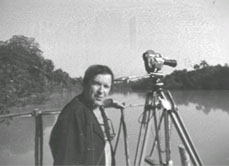
THESMANEWS
Present Issue
Past Issues
Journals
Present Issue
Past Issues
Letters to the Editor
![]()
![]()
This site is supported by Health ONE
Materia-non-Medica- "Thirty-Three Years Enchanted by Fireflies"
"The dimension of the triangle formed by the three fireflies remained constant and were independent of the spped of rewinding. This was clear evidence that the fireflies were in synochrony."
Almost fifty years ago, my students and I were on the Epidemiological Field Exercise of the DPH course. At the Sedili River near Teluk Makhota (Jason’s Bay) in Johor, I had found an endemic focus of Brogiasis (Malayan Filariasis). The Emergency was on and we had to sleep at Kampung Kuala Sedili for safety’s sake. Returning to the Kuala by boat we saw the fireflies on the mangrove trees lining the riverbanks – hundreds and thousands of them, giving off flashes in perfect synchrony.
In 1966, I happened to spend my weekend in the home of the Headman of the Orang Kuala at Kuala Benut on the West Coast of Johor. I had with me Jean-Marie Bassot, a French student of bioluminescence. The Headman asked me one question, "Any synchronously flashing fireflies around here?" I said I did not know, but that is what started me off on my infatuation. Within minutes, we were paddling up-river to look for fireflies. They were just round the first bend of the river, sitting on the leaves of the bushes in great numbers. Putting your head into a bush you felt as if your brain was being completely taken over by the fireflies’ regular rhythm. We put a single-lens reflex camera on a tripod and focused on three fireflies perched on leaves. We took a still photo and rewound the film by hand. The dimensions of the triangle formed by the three fireflies remained constant and were independent of the speed of rewinding. This was clear evidence that the fireflies were in synchrony. The camera also showed that the flashes were in pairs with peaks about 60ms apart. Professor Louis Hon of the Physics Department of the then University of Singapore rigged up a sensitive photo-multiplier photometer for me. It had a sampling frequency that allowed a precise waveform, of the fireflies’ light output over time, to be displayed on a cathode ray oscilloscope. This image could then be captured on camera.
Unfortunately the sampling frequency of present video camcorders is far too low.
As a result a flash image appears in one or two adjacent video frames, so the waveform cannot be shown. A way to overcome this limitation is to use two sound channels to record photometric data from one or two photometers. Another problem cropped up, which was the different frequency ranges between the light intensity of the fireflies and the audio tape recorders. Plugging the photometer directly into the audio input of the video camera gives horribly distorted recordings because of this mismatch. The best solution is to use Frequency Modulation (FM) coding. The other useful tool is a light controller, which can produce pulses of desired frequency, duration and waveform. With such equipment it was easy to synchronise a firefly to such an "artificial firefly".
Pteroptyx malaccae is the classical "perfect" synchroniser. It is not easy to tell whether a waveform is produced by one or by 100 such insects, so regular is the rhythm and so precise the synchrony.
Pteroptyx tener is a 5 mm long firefly, which produces up to 4 flash cycles per second. This species can establish synchrony within two or three flash cycles.
Most astonishing is Pteroptyx gelasina, a new species which I found in Sabah. They flash so rapidly that they appear to be glowing continuously in perfect synchrony.
It is also possible to plot a Phase-Response Curve for each firefly species. This plots the amount of advance or retardation of flashes, following an out-of-time flash of an "artificial firefly", against the position of the artificial firefly relative to the firefly’s previous flash. This phase-response curve is a kind of fingerprint, which defines and describes the synchronisation process.
I will end with a few words about the general biology of Pteroptyx fireflies. They are small, 5 - 10mm long, brown beetles of the group Lampyridae, most of which are luminous. The aggregation of perching fireflies in trees clearly protects them against Keringga ants and bats as they are quite palatable, unlike most other fireflies whose males patrol the area emitting their characteristic lights in anticipation of an appropriate response from females. As to the benefits of synchrony, an intermittent flash is more effective as a stimulus than the same light output delivered as a continuous glow.
Humans at least can see a firefly tree at twice the distance if the flashes are synchronous.
But studies like this can never be finished in the few years I have left. This is particularly true with so many other competing interests which I have in this wonderful part of the world, such as the collection of ancient Eastern ceramics and the organisation of my archives of tapes of life in the region in the fifties and sixties.
DR IVAN POLUNIN

The author in 1982 in Kampong Kuantan, near Kuala Selangor. He was acting as cameraman for the BBC's first firefly film. Ten years previously, he had found this firefly site, which is now visited by over 100 people a night, a very successful form of eco-tourism.